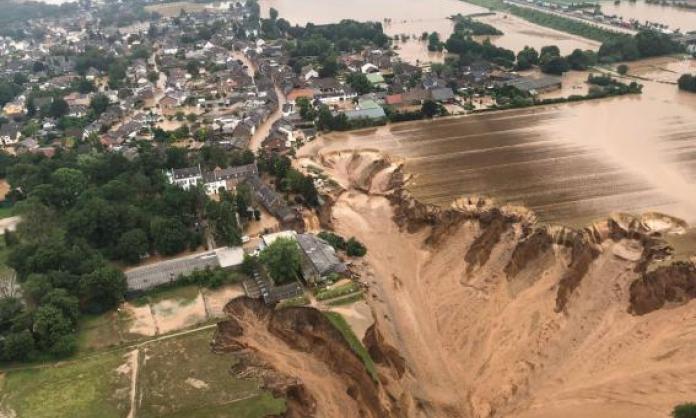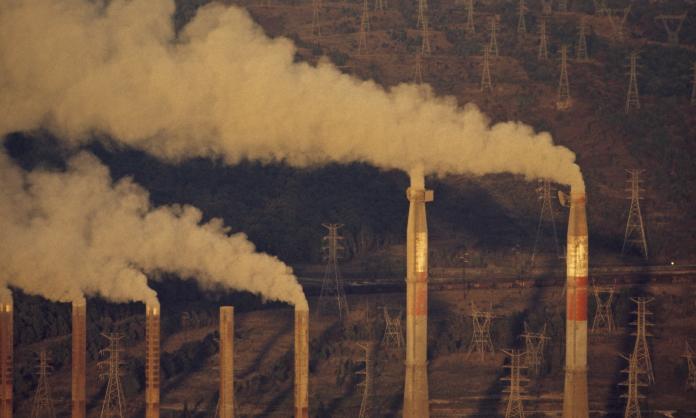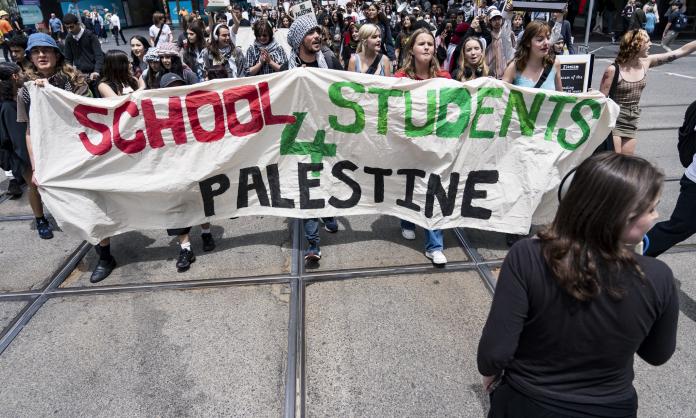In the first days of 2022, Netflix announced that the film Don’t Look Up had smashed the streaming platform’s record for most viewing hours in a week. The film—a black comedy about a group of scientists who discover an asteroid on a collision course with Earth—received mixed reviews from critics. But it struck a chord for many climate scientists, activists and writers about climate change with its satire of the failure of global leaders to deal anywhere nearly adequately with the climate crisis.
Did the film’s popularity have any discernible real-world impact? Of course not. It was an enjoyable but momentary relief. The reality the film satirised—of increasingly urgent warnings about the threat to human civilisation being laughed off by media pundits and dismissed or distorted by those in power to suit their own immediate political ends, and of the genuine efforts of those with the knowledge and skills required to forge a path out of the crisis being ignored in favour of self-aggrandising non-solutions offered by billionaire “visionaries”—is still very much our reality.
In fact, the real-world politics of climate change is in some respects darker than Don’t Look Up’s black comedy depicts. Among those who in recent years have been fighting hardest for our political leaders to “look up” and take the climate crisis seriously, the threat is not just of being ridiculed or ignored, but of being arrested and jailed. This was the fate of Deanna “Violet” Coco, for example, who was recently sentenced by a NSW court to fifteen months’ jail, with a non-parole period of eight months, for a protest in April during which she blocked a lane of traffic on the Sydney Harbour Bridge for 25 minutes and lit a flare. Other activists are likely to follow.
You might argue that these kinds of disruptive actions are unnecessary—that it’s enough to sit back and let the “green transition” roll. You’d be wrong. Talk of a “green transition” can’t be taken seriously. If such a transition were underway, there would have been at least some sign of a shift in what are the most reliable markers of progress: concentrations of greenhouse gases in the atmosphere. But to the extent that there has been a shift, it has been in the direction of accelerated warming.
Atmospheric concentrations of three key greenhouse gases—carbon dioxide, methane and nitrous oxide—all hit record highs in 2021 (the last year for which data is available). In addition, the rate of increase of these concentrations is growing. According to the US National Oceanic and Atmospheric Administration, the average concentration of CO2 in the atmosphere in 2021 was 416 parts per million (ppm). This compares to 354 ppm in 1990, 370 ppm in 2000 and 390 ppm in 2010. The rate of annual increase has risen from an average of 1.5 ppm in the 1990s, to 2 ppm in the 2000s, to 2.4 ppm in the 2010s.
It’s a similar story with methane, which, in the short-term at least, is a much more potent driver of warming than CO2. The concentration of methane in the atmosphere was 1,909 parts per billion (ppb) in November 2021, up from 1,774 ppb in 2005. Over that period, the average rate of annual increase has risen from 5.2 ppb to 9.6 ppb.
We should expect these measures to lag whatever happens on the level of emissions. So perhaps, despite the concentrations of greenhouse gases in the atmosphere continuing to rise, we’re starting to see the production of such gases fall? Unfortunately not. Global CO2 emissions from fossil fuels are projected to hit a new record of 37.5 billion tonnes this year, up 1 percent from 2021. Methane emissions from the energy sector are up too, with a steep rise of almost 5 percent from 2020 to 2021, likely to continue into this year.
Is there, at least, a more positive story to tell about what we’re likely to see in coming years? One indicator of that is what’s happening on the level of investment and the economics of energy production. Another is what’s happening in politics.
On the first measure, there is, in fact, some good news to report. Investment in renewable energy is rising. The International Energy Agency expects the total to exceed US$1.4 trillion in 2022, which will account for almost three-quarters of the growth in overall energy investment. “The annual growth rate in clean energy investment in the five years after the signature of the Paris Agreement”, the agency notes, “was just over 2 percent. Since 2020 the rate has risen to 12 percent, well short of what is required to hit international climate goals, but nonetheless an important step in the right direction”.
This growing investment is in large part due to continued falls in the cost of renewables relative to fossil fuels. It is now significantly cheaper per unit of energy produced to build new large-scale solar energy installations or wind farms than it is to construct new gas or coal plants.
Most observers are no doubt familiar with this side of the story. Fossil fuel executives, governments and many climate NGOs have an interest in boosting any and all signs that, despite rising emissions, the much vaunted “green transition” is finally here. But this is only a small part of the picture. When you zoom out to see how recent rises in renewable energy investment sit relative to the gargantuan size of the global energy system, a rather less hopeful story emerges.
The core problem is that, while renewable energy investment and production are growing, they are being outstripped by growth in overall energy demand. And the gap between them is being filled by fossil fuels. That’s why the oil, coal and gas industries remain extremely profitable, and why investors continue to back major new fossil fuel projects.
We are currently, in fact, in the midst of a renewed fossil fuel boom. According to the IEA, “net income for the world’s oil and gas producers is set to double in 2022 to an unprecedented US$4 trillion”. Even the coal industry, widely thought to be in terminal decline, is having a moment. “Around US$105 billion was invested in the coal supply chain in 2021”, the IEA writes, “an increase of 10 percent year-on-year, and a further 10 percent rise is expected in 2022 as tight supply continues to attract new projects”.
The second indicator of what we’re likely to see in coming years is politics. What’s happening here can’t be understood without reference to the economic factors discussed above. Those factors explain the dual approach taken by governments in major fossil fuel producing countries such as Australia and the US—involving the very loud and public promotion of all things green and renewable on the one hand, intended to obscure continued, massive support for the fossil fuel industry on the other.
This is exactly the strategy adopted by Australia’s Labor government, which came to power in May in part because of public support for more serious climate action. Its main “achievement” in this area to date has been to raise Australia’s emissions reduction target to 43 percent below 2005 levels by 2030, up from 26-28 percent under the Coalition government that preceded it. The new target is vastly inadequate. As one of the richest countries on Earth, and one of the highest per capita contributors to global emissions, Australia should be leading the world, rather than doing what amounts to the bare minimum. But Labor’s climate bill was nevertheless passed with the support of the Greens, and greeted with widespread approval by the media and major environmental organisations.
At the same time, the government is doing everything in its power to ensure that Australia’s fossil fuel giants don’t miss out on the profits bonanza from the war in Ukraine and the inflated price of oil, coal and gas on global markets. It has given no indication that it intends to cut subsidies to the industry, which amounted to $11.6 billion in the 2021-22 financial year. It has promised billions for new fossil fuel projects such as the Middle Arm Petrochemical plant in the Northern Territory—which will process fracked gas from the enormous new reserves being opened in the Beetaloo Basin.
The ALP has also refused to implement anything like the kind of windfall profits tax imposed by the British government on oil and gas companies. Even in the context of imposing a price cap on coal and gas on the domestic market, it hasn’t ruled out providing “incentives” (i.e. millions in taxpayer funds) to soften the blow to producers’ current gigantic profits.
Governments in Australia and elsewhere use “offsetting” to attempt to square the circle of more ambitious emissions reduction targets combined with the ongoing expansion of the fossil fuel industry. Just like the Coalition before it, Labor expects us to believe that tree planting, carbon capture and storage, and other more or less completely unproven schemes will somehow, at some indeterminate point in the future, wipe the slate clean. To describe this prospect as fantasy is too generous. It is more appropriately classified as “true crime”.
In light of all this, we should be seeing ongoing protest and disruption on a much greater scale than that caused by Violet Coco’s brief sit-in on the Sydney Harbour Bridge. The situation is worse, and the urgency of transformative change greater, today than it was in 2019 when millions participated in the school strike movement and groups such as Extinction Rebellion were mobilising thousands.
So why aren’t we? The COVID-19 pandemic has no doubt played a role. But the main issue is political. The mainstream of the climate movement—which includes parties such as the Greens, along with major environmental NGOs and more conservative activist groups like School Strike 4 Climate—has shown little interest, over the past year, in calling on people to protest. This was already apparent before the federal election, when the movement’s horizon of action became more and more limited to simply winning a change of government. If your goal was to win a new government, after all, it makes sense to “give them a chance” once they get in.
There’s no easy way to turn things around. It’s clear that we need a return to mass, defiant protest—the kind that doesn’t leave activists isolated and liable to face the full force of an increasingly repressive state. It’s clear, also, that for us to win the kind of genuinely transformative change we need will require the involvement of organised workers, such as we saw in Australia in the 1970s with the Builders Labourers Federation’s Green Bans. Getting to that point, however, will require much more than simply organising handfuls of union officials to attend climate marches, which has been the practice of sections of the left in recent years.
In the short term, activists should do what we can, where we can. Better to keep the flame of protest alive, even if only flickering, than to allow it to be extinguished altogether. Those few, like Violet Coco, who are fighting on despite their isolation, are to be commended. In the coming months, a key task will be to stand in solidarity with them and push back against the wave of state repression being unleashed.
Beyond that, convincing more people to “look up” in a political sense—to engage with visions of change that go beyond the very limited, and always “market friendly”, solutions offered by the dominant forces in politics and the climate movement itself—remains a key task. Perhaps the one real bright spot in the otherwise gloomy prospect of the climate crisis in 2022 has been the increasing preparedness of climate scientists and activists to do just that, raising the hope that when we do see a resurgence in the climate movement, it will be one with a more radical, socialist politics at its core.











